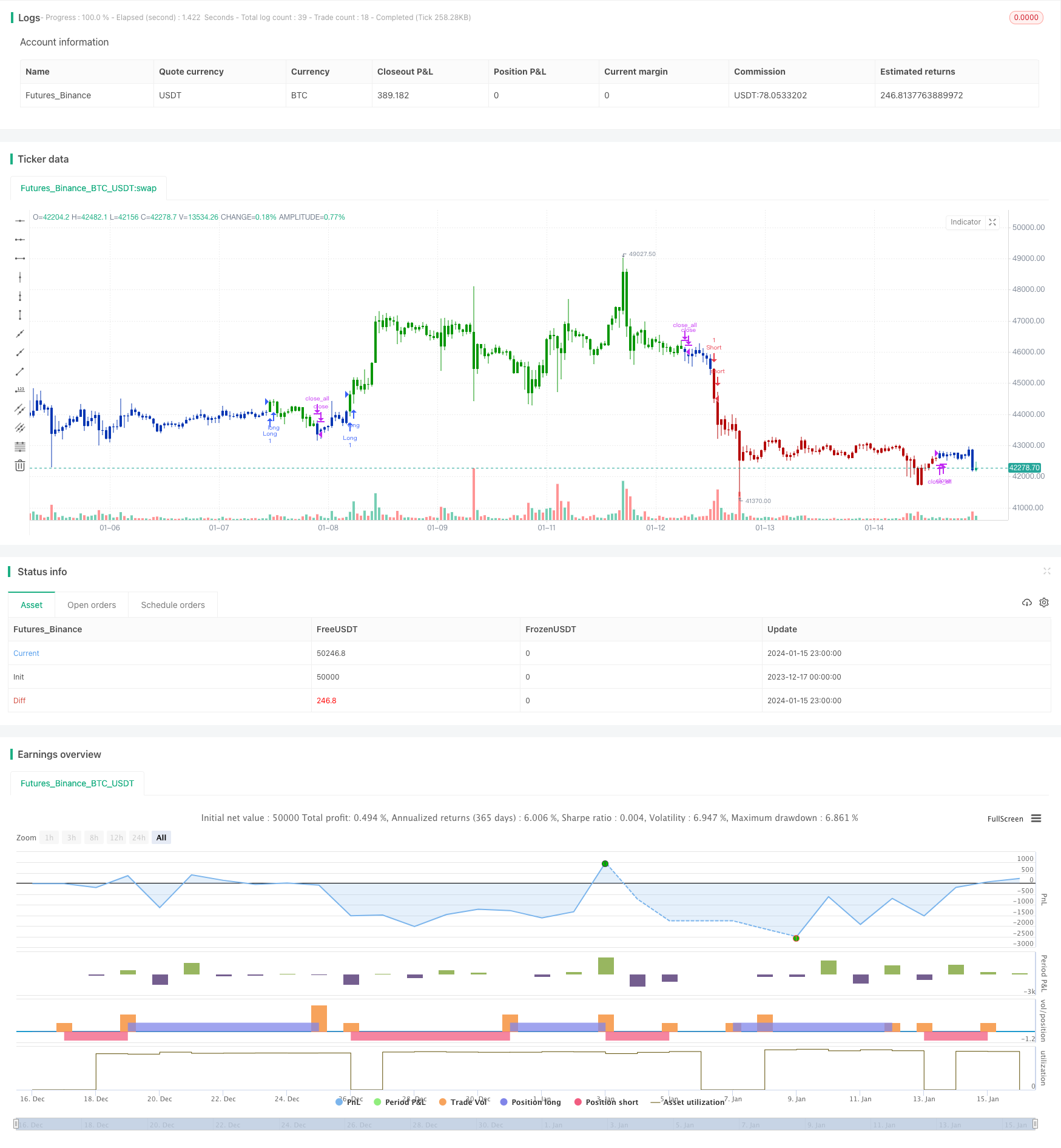
概述
双重确认反转趋势追踪策略融合了123形态反转策略和支撑阻力位突破策略,实现了对价格反转信号的双重确认,从而过滤掉部分噪音交易信号,提高策略胜率。
该策略主要应用于中长线交易。它在价格形成反转信号时,会同时检测是否突破关键的支撑或者阻力位,双重确认后才产生交易信号。
策略原理
双重确认反转趋势追踪策略由两部分组成:
123形态反转策略
通过比较前两根K线的收盘价,判断价格是否出现反转形态。再结合随机指标判定震荡度,过滤误报机会。
支撑阻力位突破策略
使用前一日的最高价、最低价和收盘价计算支撑位和阻力位。监测价格是否突破这些关键位。
当价格同时满足这两个策略的交易信号时,认为反转信号得到双重确认,产生最终的交易指令。
策略优势
- 双重信号确认,可靠性更高
- 反转追踪,及时捕捉转折机会
- 随机指标辅助,有效过滤假突破
策略风险
- 双重确认导致少量机会被过滤
- 大趋势下的反转失败风险
可通过参数优化,调整双确认严格度,平衡策略胜率和盈利次数。
策略优化
- 调整 stochastic 参数,优化震荡度过滤
- 测试不同日线计算支撑阻力位
- 增加止损策略,降低大趋势下反转风险
总结
双重确认反转趋势追踪策略成功结合反转形态和关键位突破的优点,在提高信号质量的同时,保证了交易次数,是一种适合中长线趋势交易的策略。参数调整和止损策略的加入,能够进一步增强策略的稳定性和实战性。
策略源码
/*backtest
start: 2023-12-17 00:00:00
end: 2024-01-16 00:00:00
period: 1h
basePeriod: 15m
exchanges: [{"eid":"Futures_Binance","currency":"BTC_USDT"}]
*/
//@version=4
////////////////////////////////////////////////////////////
// Copyright by HPotter v1.0 15/09/2020
// This is combo strategies for get a cumulative signal.
//
// First strategy
// This System was created from the Book "How I Tripled My Money In The
// Futures Market" by Ulf Jensen, Page 183. This is reverse type of strategies.
// The strategy buys at market, if close price is higher than the previous close
// during 2 days and the meaning of 9-days Stochastic Slow Oscillator is lower than 50.
// The strategy sells at market, if close price is lower than the previous close price
// during 2 days and the meaning of 9-days Stochastic Fast Oscillator is higher than 50.
//
// Second strategy
// The name ‘Floor-Trader Pivot,’ came from the fact that Pivot points can
// be calculated quickly, on the fly using price data from the previous day
// as an input. Although time-frames of less than a day can be used, Pivots are
// commonly plotted on the Daily Chart; using price data from the previous day’s
// trading activity.
//
// WARNING:
// - For purpose educate only
// - This script to change bars colors.
////////////////////////////////////////////////////////////
Reversal123(Length, KSmoothing, DLength, Level) =>
vFast = sma(stoch(close, high, low, Length), KSmoothing)
vSlow = sma(vFast, DLength)
pos = 0.0
pos := iff(close[2] < close[1] and close > close[1] and vFast < vSlow and vFast > Level, 1,
iff(close[2] > close[1] and close < close[1] and vFast > vSlow and vFast < Level, -1, nz(pos[1], 0)))
pos
FPP() =>
pos = 0
xHigh = security(syminfo.tickerid,"D", high[1])
xLow = security(syminfo.tickerid,"D", low[1])
xClose = security(syminfo.tickerid,"D", close[1])
vPP = (xHigh+xLow+xClose) / 3
vR1 = (vPP * 2) - xLow
vS1 = (vPP * 2) - xHigh
pos := iff(close > vR1, 1,
iff(close < vS1, -1, nz(pos[1], 0)))
pos
strategy(title="Combo Backtest 123 Reversal & Floor Pivot Points", shorttitle="Combo", overlay = true)
Length = input(15, minval=1)
KSmoothing = input(1, minval=1)
DLength = input(3, minval=1)
Level = input(50, minval=1)
//-------------------------
reverse = input(false, title="Trade reverse")
posReversal123 = Reversal123(Length, KSmoothing, DLength, Level)
posFPP = FPP()
pos = iff(posReversal123 == 1 and posFPP == 1 , 1,
iff(posReversal123 == -1 and posFPP == -1, -1, 0))
possig = iff(reverse and pos == 1, -1,
iff(reverse and pos == -1 , 1, pos))
if (possig == 1)
strategy.entry("Long", strategy.long)
if (possig == -1)
strategy.entry("Short", strategy.short)
if (possig == 0)
strategy.close_all()
barcolor(possig == -1 ? #b50404: possig == 1 ? #079605 : #0536b3 )